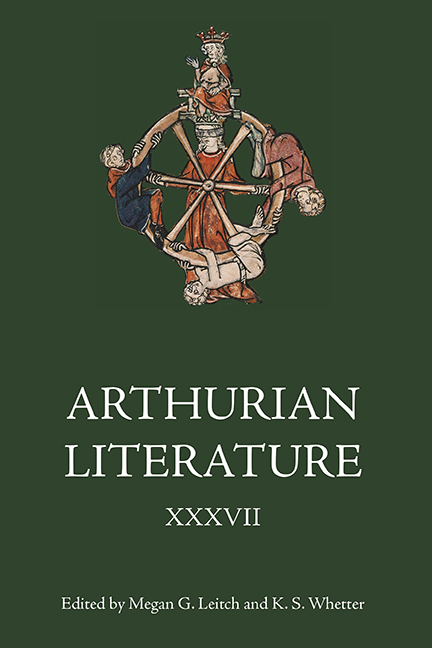Book contents
- Frontmatter
- Contents
- List of Charts and Tables
- Professor Fiona Tolhurst (1968–2021)
- General Editors’ Preface
- List of Contributors
- List of Abbreviations
- Introduction: The Tournament at Mapplemalleoré: Malory at 550
- 1 Malory and the Stock Phrase
- 2 The Artistry of Malory’s Mercantile Metaphors: Goods, Generosity, and the Source of ‘The Tale of Sir Gareth’
- 3 ‘A grete bourder and a passynge good knyght’: Sir Dinadan: ‘Gareth with a Twist’
- 4 Moonlight in the Nocturnal Typology of Malory’s Morte Darthur
- 5 ‘That shall nat ye know for me as at thys tyme’: Cognitive Narratology and Filling Malory’s Gaps
- 6 ‘On a tyme’: Action and Temporality in Malory’s ‘Sankgreal’
- 7 Hospitality in Malory
- 8 The Haunting of the Orkneys and Malory’s Arthurian Project
- 9 ‘I love nat to be constreyned to love’: Launcelot and Coerced Sex
- 10 Eradicating Victorian Backreading: Re-reading Malory’s Gwenyvere through Gaynour and Isode
- contents of previous volumes
3 - ‘A grete bourder and a passynge good knyght’: Sir Dinadan: ‘Gareth with a Twist’
Published online by Cambridge University Press: 15 September 2022
- Frontmatter
- Contents
- List of Charts and Tables
- Professor Fiona Tolhurst (1968–2021)
- General Editors’ Preface
- List of Contributors
- List of Abbreviations
- Introduction: The Tournament at Mapplemalleoré: Malory at 550
- 1 Malory and the Stock Phrase
- 2 The Artistry of Malory’s Mercantile Metaphors: Goods, Generosity, and the Source of ‘The Tale of Sir Gareth’
- 3 ‘A grete bourder and a passynge good knyght’: Sir Dinadan: ‘Gareth with a Twist’
- 4 Moonlight in the Nocturnal Typology of Malory’s Morte Darthur
- 5 ‘That shall nat ye know for me as at thys tyme’: Cognitive Narratology and Filling Malory’s Gaps
- 6 ‘On a tyme’: Action and Temporality in Malory’s ‘Sankgreal’
- 7 Hospitality in Malory
- 8 The Haunting of the Orkneys and Malory’s Arthurian Project
- 9 ‘I love nat to be constreyned to love’: Launcelot and Coerced Sex
- 10 Eradicating Victorian Backreading: Re-reading Malory’s Gwenyvere through Gaynour and Isode
- contents of previous volumes
Summary
Sir Dinadan, son of Sir Brunor Senior and trusted friend of Sir Tristan, is without a doubt the most ‘modern’ of all the characters in the wide universe of medieval Arthurian literature, Sir Thomas Malory's Morte Darthur included. First introduced to the world in the Old French Prose Tristan, he has been described in modern scholarship as a ‘counter-hero’, a ‘Knight with reservations’, a ‘bufón y caballero salvaje’ (‘jester and wild knight’), a ‘foil’, a ‘misfit’, an ‘anti-knight’ and even ‘disturbing and reassuring’. In the words of one critic, he is ‘a reluctant knight, devoted friend, skillful parodist, mocker of chivalric custom and’, despite all of this, ‘a supporter of chivalric ideals’.
Ever since the first modern critical appraisal of Sir Dinadan by Eugène Vinaver in 1925, readers have struggled to understand where he came from and what his function really is in the French, Italian, Iberian and English continuations and adaptations of the original Old French text. Stefano Mula claims that Dinadan was created to fill a gap left by Sir Kahedin, who in the Prose Tristan loves Iseult, excites Tristan's jealousy and triggers his madness. Kahedin meets an untimely end, leaving Tristan without a close friend; enter Dinadan, who appears out of nowhere and like Kahedin before him, is harshly critical of chivalric excesses. Dinadan takes the latter's place and serves as the reasonable half of Tristan, ‘someone with more sensible views on the world’. In the Old French Prose Tristan he is used to illustrate knightly virtues and vices, and in Vinaver's words, ‘Dinadan is perhaps the most human, if not the most attractive character in the French romance’.
Needless to say, Malory made some notable and significant changes to the character of Dinadan from what he found in his French sources. I have neither the space nor the need to review all of these here. In what follows I wish simply to remind the reader of two aspects of Dinadan's characterization in the Morte Darthur, namely Malory's emphasis on knightliness and the ultimately positive portrayal of Dinadan, before highlighting a third aspect, following which I will briefly highlight a potentially significant connection between this exceptional character and Sir Gareth that has gone virtually unnoticed.
- Type
- Chapter
- Information
- Arthurian Literature XXXVIIMalory at 550: Old and New, pp. 49 - 66Publisher: Boydell & BrewerPrint publication year: 2022



